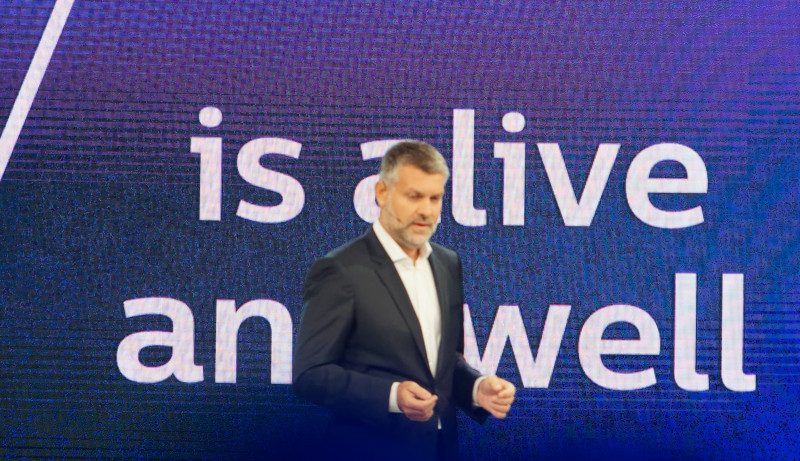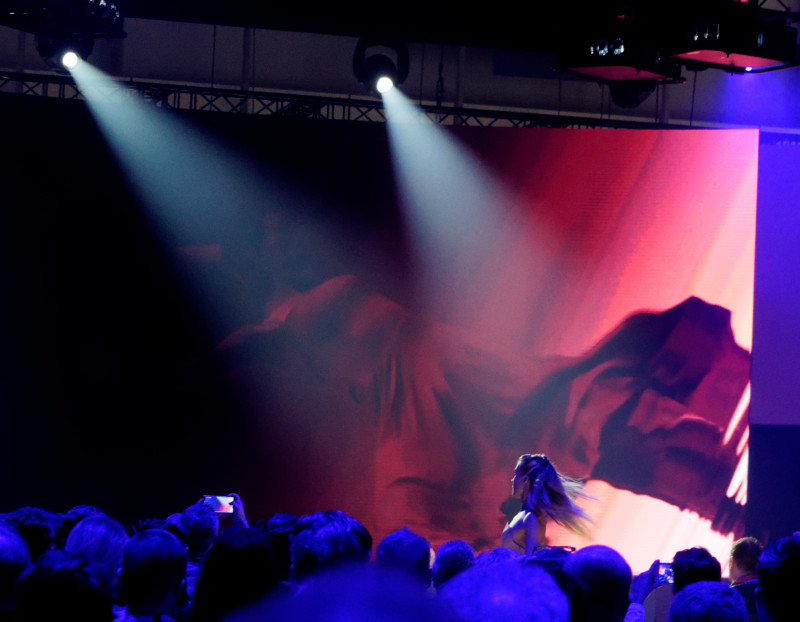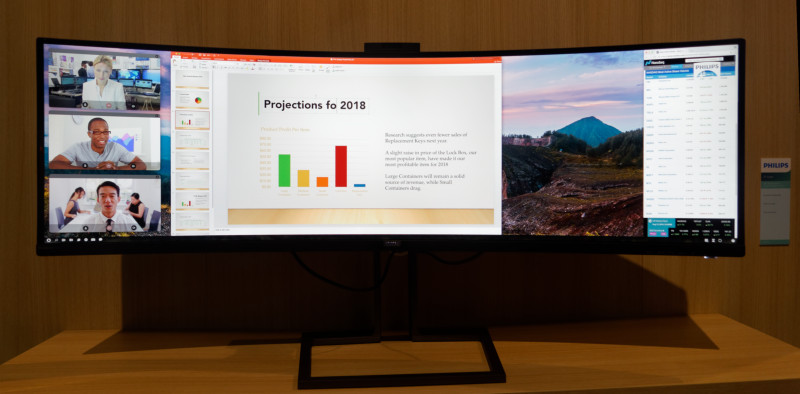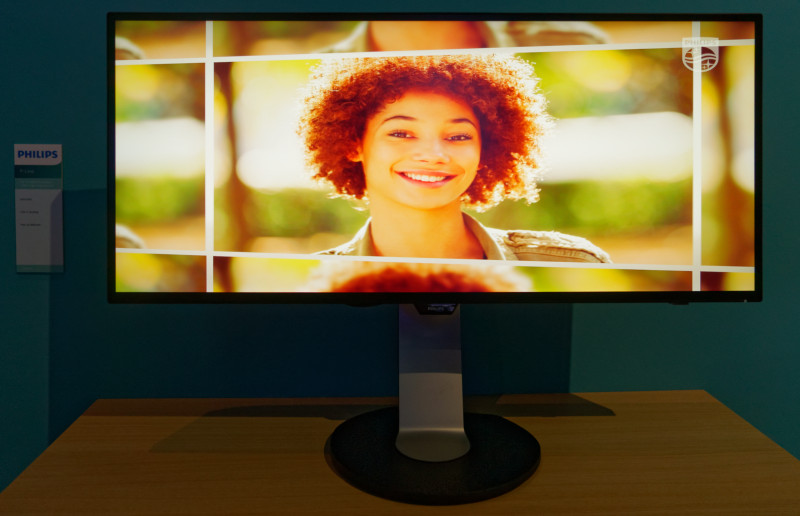Philips held its usual big press conference in the back area of its booth, which is then used for supplier and partner meetings. The first topic was health and lifestyle and topics covered include a new device for ‘smart sleep’ and a connected blender that can track the calories used in smoothies. The company also has a new toothbrush that is connected to the internet and can open up possibilities of ‘teledentistry’.
Kostaz Vouzas is from TP Vision which was founded in 2012, the year that FaceBook went on the stock market – and Vouzas said that this was the year when many forecast a decline in TV viewing. However, TV is alive and well and is the hub of the smart home, even though smartphones and tablets have provided alternative ways of viewing.
 Vouzas said that TV is ‘Alive & Well’ – Image:Meko
Vouzas said that TV is ‘Alive & Well’ – Image:Meko
Vouzas said that the firm has tried to design the TVs that the management would like in their homes.
Philips has been working with Danish designer, Georg Jensen, on new TV designs and has won 62 awards since IFA last year in Europe. The OLED 9002 has been very successful and last year P5 processing was introduced. Can it be improved, he asked? The OLED 803 is better, he said. It has the second generation P5 processor and it has new tone mapping that makes SDR like HDR .
Buyers also want good sound and TPV will take over Philips audio licence and there will be new products later.
TP Vision is working with B&W on good sound, which has been made made more difficult by the development of flat panel TVs which reduce the space needed for great sound. So, the company has partnered with UK-based Bowers & Wilkins, whose speakers are used by Abbey Road and many other recording studios and whose products are used in premium automotive products from Maserati and BMW.
The OLED 903 TV has a new B&W sound bar and that apparently was the trigger for the progress of a spotlit ballet dancer moving through the audience at the press event.
 The new OLED TV was apparently a trigger for this dancer. Image:Meko
The new OLED TV was apparently a trigger for this dancer. Image:Meko
Vouzas emphasised that the new 903 is ‘not just another OLED’ and not even ‘just another premium OLED’ – a message that was also highlighted on the booth. (This highlights a problem with OLED. With only one supplier and just two different panels, it is getting harder for brands to differentiate their products. It is not helped by the wide variety of different LG OLED TVs, including some that are relatively low priced and sold through discount channels – Man. Ed.)
That was the end of the TV section and the rest of the event was devoted to the Hue family of programmable lighting products (now five years old) including Hue Sync, Hue Play (partnered with Razer), Hue Signe for outdoor applications and later there will be Siri shortcuts for voice control.
Booth Tour
On the booth, we looked at the P5 “Perfect Natural Reality” feature which converts SDR to HDR using the second generation P5 processor because there is little HDR content available to consumers, so far. The technology also has other improvements in contrast enhancement. The 803/903 OLED panel has up to 1000 cd/m2 of output and a better polariser. The 803 has better sound than last year’s 902, we heard. Philips is also adding support for HDR10+
One reason for going with HDR10+ rather than Dolby Vision at this stage is that P5 has its own picture processing, but Dolby Vision does not allow some of features of the P5 processing. That’s not a problem with HDR10+ content.
The Georg Jensen TV design from Philips is very slim. Image:Meko
The Georg Jensen design was very slim although staff pointed out that one reason that Philips has not made a wallpaper TV as it needs some space behind the TV for its trademark Ambilight feature. The remote control is also very geometric and slim. We had heard that the design might use a QD on Glass concept, but staff on the booth told us that the panel was not of that type – just a standard edge-lit panel, they told us. The 9104 is the first product that will come from the partnership, in 2019, and will us an LG Nano Cell IPS panel and will be available in 55″ and 65″.
The Android-based TVs support Amazon’s Alexa voice control system.
Monitors
As usual, monitors were not mentioned in the press event (we assume that MMD doesn’t contribute to that element of cost!), but were shown in one section of the booth. There were a number of new models on show.
The 34″ 3440 x 1440 349P7F monitor which is a curved unit that can act as a USB Type-C dock (with up to 60W of charging) and has a three-sided borderless design. The Philips label on the bottom of the display can be flipped out of the way if the user wants to tile multiple monitors together. The panel is an MVA type with 300 cd/m² of output and 3,000:1 contrast. It will sell for around €800.
The company also had a new version of the 49″ curved monitor that it first showed a year ago, but never brought to market. The first version was just 1080 lines in vertical resolution and that was considered as not deep enough for many applications, so the new version, the 499P9H uses a 5120 x 1440 panel. It has USB Type-C docking (with around 60W of power) and a pop-up webcam that supports Windows Hello.

Also in the ‘5K’ class, Philips was showing a 34″ monitor with 21:9 format and 5120 x 2160 resolution, a new format, effectively a wider version of the 27″ UltraHD format. Unlike some other wide format monitors, this one, the 34P9H, is not curved and is one of the new P Line of professional monitors. (We suspect that the problem is that at these higher resolutions, the alignment of the curved LCD and the backlight becomes problematic).

The third member of the new P line is a 32″ UltraHD unit, the 329P9H, that is designed as a USB Type-C docking product. Features include a four-sided ‘frameless’ design and a pop-up camera.
Philips had the ‘Momentum’ line of gaming displays which is one of the few ranges of monitors in the market that is aimed at console gamers. Plenty of brands are targeting PC games, but, as staff told us, there is a kind of ‘religious divide’ between console and PC gamers. The 43″ UltraHD monitor, the 436M6VBPAB, has ambiglow (a variant on Ambilight) and uses a 4ms MVA panel with 4,000:1 native contrast. Inputs include a single HDMI (criticised in some reviews), and both full-size and mini-DisplayPort as well as Type-C connector with DisplayPort Alt mode support. The colour support, using QD film, is 100% of Rec. 709 and 97.6% of DCI-P3 and the monitor has a 720 cd/m2 output with 1,000 cd/m2 peak, allowing support for the DisplayHDR 1000 certification.
Finally, we looked at a 17″ 5:4 PCap touch monitor and a 21.5″ version, the 171B9T and 221B9T, which have TN panels and are water and dust proof to IP54. “So”, we said, “you are going after Iiyama?”. The smile that we got in recognition suggests that this is the plan!
As well as the P Line, Philips was showing a new E Line of entry level professional monitors which have IPS panels. The 276C8, 278E9Q, and 328E9F have three side frameless designs and the 27″ and 32″ are curved. The flat one is 6.1mm thick and the others are 9.94mm.

